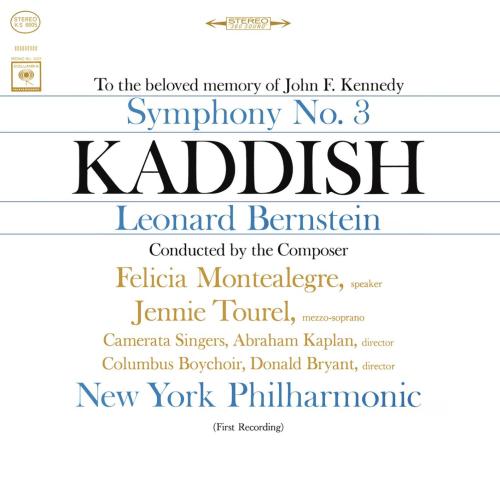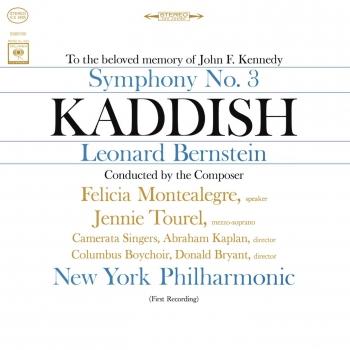
Bernstein: Symphony No. 3 "Kaddish" (Remastered) Various Artits
Album Info
Album Veröffentlichung:
1964
HRA-Veröffentlichung:
09.03.2017
Das Album enthält Albumcover
Entschuldigen Sie bitte!
Sehr geehrter HIGHRESAUDIO Besucher,
leider kann das Album zurzeit aufgrund von Länder- und Lizenzbeschränkungen nicht gekauft werden oder uns liegt der offizielle Veröffentlichungstermin für Ihr Land noch nicht vor. Wir aktualisieren unsere Veröffentlichungstermine ein- bis zweimal die Woche. Bitte schauen Sie ab und zu mal wieder rein.
Wir empfehlen Ihnen das Album auf Ihre Merkliste zu setzen.
Wir bedanken uns für Ihr Verständnis und Ihre Geduld.
Ihr, HIGHRESAUDIO
- Leonard Bernstein (1918-1990): Kaddish, Symphony No. 3 (To the Beloved Memory of John F. Kennedy):
- 1 I. Invocation - Kaddish 1 08:23
- 2 II. Din-Torah - Kaddish 2 15:58
- 3 III. Scherzo - Kaddish 3 - Finale 18:31
Info zu Bernstein: Symphony No. 3 "Kaddish" (Remastered)
„Kaddish“ is Leonard Bernstein's third symphony. The 1963 symphony is a dramatic work written for a large orchestra, a full choir, a boys' choir, a soprano soloist and a narrator. The name of the piece, Kaddish, refers to the Jewish prayer that is chanted at every synagogue service for the dead but never mentions "death."
The symphony is dedicated to the memory of John F. Kennedy who was assassinated on November 22, 1963, just weeks before the first performance of the symphony. Leonard Bernstein wrote the text of the narration himself, but struggled with his own motivation for the aggressiveness of the text. In 2003, after talks with Bernstein shortly before his death, Holocaust survivor Samuel Pisar added a new narration about his personal experiences and how his family suffered and perished in the Holocaust, and his subsequent struggle with his belief. The Bernstein estate allows this version only to be used with Samuel Pisar as recitator.
„To the Jews of the world, the word Kaddish ("Sanctification") has a highly emotional connotation, for it is the name of the prayer chanted for the dead, at the graveside, on memorial occasions and, in fact, at all synagogue services. Yet, strangely enough, there is not a single mention of death in the entire prayer. On the contrary, it uses the word chayei or chayim ("life") three times. Far from being a threnody, the Kaddish is a series of paeans in praise of God, and, as such, it has basic functions in the liturgy that have nothing to do with mourning.
This doxology (the first two sections) is written in a mixture of Hebrew and Aramaic, the vernacular language at the time of Jesus. In fact, there is reason to believe that the doxology became the basis for the Christian Paternoster (Lord's Prayer). Originally, in the period following the destruction of the Second Temple (70 A.D.), fragments of the Kaddish recited by a preacher at the end of an discourse when he was expected to dismiss an assembly with an allusion to the Messianic hope. It was not until the 12th century, however, that the prayer reached it's present-day form, and through folklore came to be associated with mourning.
In his Kaddish Symphony, Leonard Bernstein exploits the dualistic overtones of the prayer: its popular connotation as a kind of requiem, and its celebration of like ( i.e. creation). He does this both in his speaker's text and in his music. In the original version, the choice of a woman as the Speaker and as vocal soloist (singing sacred words traditionally reserved for men in the synagogue) was in itself a dualistic decision. The woman represented in the Symphony, that aspect of humankind which know God through intuition, and can come closest to Divinity, a concept at odds with the male principal of organized rationality. (Bernstein used the same device thirty-six years ago in his Symphony No. 1, Jeremiah, in which the Prophet's Lamentation is sung by a mezzo-soprano.
Because he was not satisfied with the original (1963) version, the composer, in 1977, made some revisions. These included a few cuts, some musical re-writing and even more re-writing of the spoken text. Furthermore, he made it possible for the speaker to be either a woman or a man.
But the dualism is more than a matter of which gender is the narrator. The Speaker mourns, in advance, humanity's possible imminent suicide. At the same time, it is observed that people cannot destroy themselves as long as they identify themselves with God. Hence, human beings as creators, as artists, as dreamers (as, therefore divine manifestations), could be immortal.
Musically, this dualism is illustrated by the dramatic contrast between intensely chromatic textures (which employ twelve-tone techniques) and simple expressive diatonicism. For example, there is a particularly anguished outburst by the Speaker in the middle of the Din-Torah (trial-scene or "Judgement by Law") in which God is accused of a breach of faith with humanity.
Such "blasphemy" has a Biblical precedent in the story of Job and also has its roots in the folk traditions, as in the legend of Rabbi Levi Yitzhok of Berditchev. Bernstein strongly felt the peculiar Jewishness of this "I-Thou" relationship in the whole mythic concept of the Jew's love of God, from Moses to the Hasidic sect, there is a deep personal intimacy that allows things to be said to God that are almost inconceivable in another religion.
This change is manifested by agonized, non-tonal music which culminates in an eight-part choral cadenza of vast complexity. But immediately after this, the Speaker begs God's forgiveness and tries to be comforting; and the ensuing lullaby is explicitly tonal, with gentle modulations.
Again, at the climax of the Symphony (in the Scherzo), another painful spoken moment, musicalized in extreme, angular motives, is followed by a gradual clarification and resolution into G-flat major. The critical word of the Speaker at this point is "believe". Indeed, the composer's credo resided in his belief in the enduring value of tonality.“ (Jack Gottlieb)
New York Philharmonic Orchestra
Leonard Bernstein, conductor
Digitally remastered
Please Note: We offer this album in its native sampling rate of 96 kHz, 24-bit. The provided 192 kHz version was up-sampled and offers no audible value!
Keine Biografie vorhanden.
Dieses Album enthält kein Booklet










